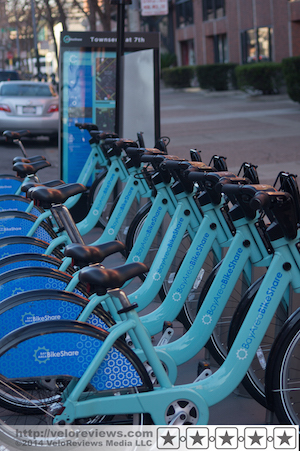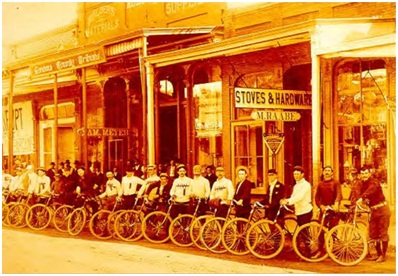Living in the city of San Francisco in 2015, you are constantly confronted with issues of class struggle and gentrification. In most parts of the city the rent you’d pay for 1 month in a 1 bedroom apartment could buy you a functional used car elsewhere in the country (or one hell of a nice bike). I also happen to live in a neighborhood that was, until recently, one of the most affordable (relatively) in the city. As a predominately African American community, this puts the area directly in the crosshairs of everything potentially bad about gentrification and displacement. Lots of new people moving in, demanding change. Lots of established families that have been in the neighborhood for generations feeling pushed out both socially and economically.
It is against this backdrop that I came face to face with an issue that at first seemed completely unfathomable for me: for many, cycling is a sign of gentrification.
 It started with a post I put on Facebook about expanding the local bike share program to my neighborhood. The Bay Area Bike Share, when initially launched, was concentrated in the more affluent areas of the city. Makes sense – when you are testing a new service you want to launch where you have the most customers (which was not my neighborhood.) However, after the concept was proven they were ready to expand their capacity by a factor of 10, and were asking for community input on where to put the new stations.
It started with a post I put on Facebook about expanding the local bike share program to my neighborhood. The Bay Area Bike Share, when initially launched, was concentrated in the more affluent areas of the city. Makes sense – when you are testing a new service you want to launch where you have the most customers (which was not my neighborhood.) However, after the concept was proven they were ready to expand their capacity by a factor of 10, and were asking for community input on where to put the new stations.
For me the addition of a Bay Area Bike Share station in my neighborhood seemed like a big win. First off, as one of the resident bikey types, I just want to see more people riding bikes in my neighborhood. I subscribe to the theory that says the more cyclists on the road, the safer it is for all cyclists.
Second, I think that bike share programs address another issue we face in San Francisco – bike theft. It is unfortunate the number of trips I didn’t take because I was nervous about my bike being stolen when locked up outside wherever it was I wanted to go. The way most bike share programs work, you take them from one station and dock them at another. No worry about the theft of your beloved whip.
Finally, I think this service actually is an economic win too. One of the complaints I got about my recommendation for a station in my neighborhood was basically that if people want to ride bikes, they’ll buy one. However, you’re looking at a few hundred bucks easy to buy a ridable bike. (Sure, you can find some damn nice bikes on the streets of San Francisco for $25-$50 bucks. Want to guess where they came from?) So you need a few hundred minimum to buy the bike, maybe another hundred or two a year in maintenance, replacement tubes, and locks. Then add on the risk of theft…. at $88 a year bike share sure looks like a cheaper alternative. How could a cheaper alternative for folks in a neighborhood where many are economically challenged possibly be a bad thing?
The person attacking my Facebook post was pretty adamant in her beliefs, and it was after much reflection that I started to understand why. For her (I’ve come to believe) people on bikes were one of two kinds: wealthy 20-something hipsters who work for tech companies, or out of town tourists that serve to water down the culture of a neighborhood.
Putting aside my doubts that she actually understands what bike share is, or that those two groups are not its target market, her complaints raised some interesting considerations.
 Historically, cycling has been concentrated on the extremes of the socioeconomic spectrum. On the one hand you had those that rode a bike because they wanted to. They tended to be folks that had enough income to support what can be – let’s face it – a rather expensive endeavor. While most of america was in love with their cars (the working person’s mode of transportation) the cyclists were mostly those with enough wealth and privilege to not really care what everyone else was doing.
Historically, cycling has been concentrated on the extremes of the socioeconomic spectrum. On the one hand you had those that rode a bike because they wanted to. They tended to be folks that had enough income to support what can be – let’s face it – a rather expensive endeavor. While most of america was in love with their cars (the working person’s mode of transportation) the cyclists were mostly those with enough wealth and privilege to not really care what everyone else was doing.
On the other hand you had those that were riding around on cobbled together bikes because they had no other option. Either from financial hardship, or past legal mistakes (like a DUI) they found cars to be unavailable, and turned to the next best thing – the bicycle.
These two extremes still exist. But bicycles have grown in both popularity and social acceptance to the point where these historical groups are the minority. The most visible group riding now – and the one most often thought of by non-cyclists – are the GenY folks that have turned to the bike instead of the car for reasons of style and ease. A fixed gear bike has usurped the coveted coming of age milestone that was once occupied by the driver’s license.
These younger urbanites are all to easy to associate with the stereotype of the “tech dude” that has become the de-facto social evil in San Francisco. The term hipster started out just as a description, morphed into a funny stereotype, then became an object of ridicule and hatred. And it is hipsters (so goes the common conception) that are the ones pushing for more bikes in the city.
The frustrating part for me is that bicycles offer a lot of opportunity for folks of all levels. That is why I think that bike share programs are actually more valuable to economically depressed areas then affluent ones. Once you have an area that can sustain such a service, the next step really should be to spread that service to parts of that community that couldn’t support it on their own. If anything I see this as an equalization of opportunity (and therefore wealth) instead of yet another divisive change that pushes the haves farther away from the have-nots.
I can fully understand why folks – fearing displacement – get upset with gentrification. I can even understand how those folks can easily direct that frustration towards any symbol they see as representative of the vague force that is threatening their way of life. But claiming that a bike share program is hastening this displacement makes about as much sense as saying that public transportation does the same thing.
If you want to preserve the unique character and culture of a particular neighborhood that is struggling economically, then you need to provide that neighborhood with every opportunity to succeed and support itself. Providing opportunities for mobility gives families the opportunity to continue to live and interact with their community in the way they always have, while still giving space and flexibility to pursue a comfortable living.
Bicycles are becoming an integral part of all parts of our society – a viable alternative to the automobile in all things. Don’t let them become the baby you throw out with the bathwater. Gentrification is a real social issue that needs to be discussed and addressed. Bikes, however, are neither a cause nor symptom of that problem.
Pingback: Google cars confused by track stands - Just Another Cyclist()
Pingback: Jeff Jacoby doesn't want you riding on his roads - Just Another Cyclist()
Pingback: Bicycle Gentrification - VeloReviews()